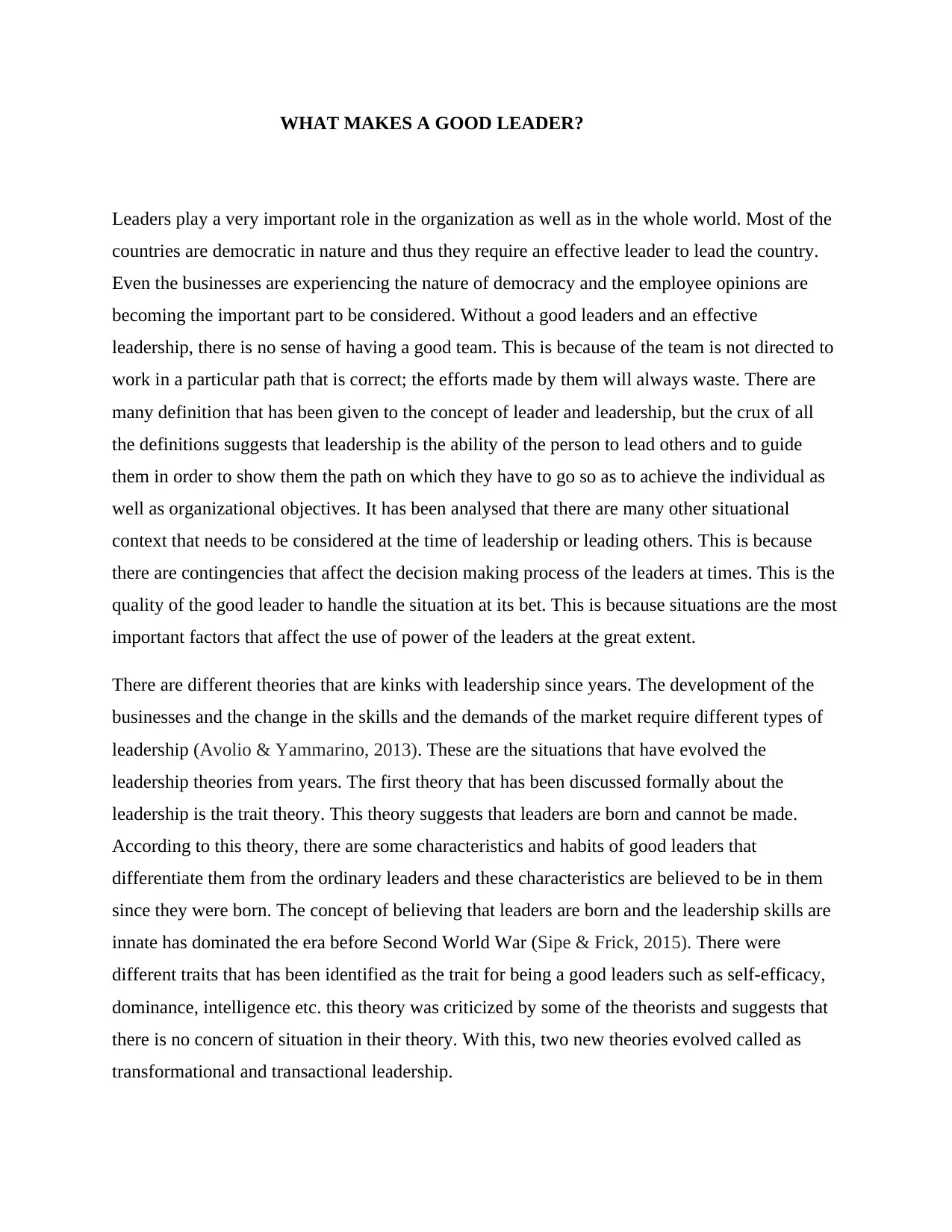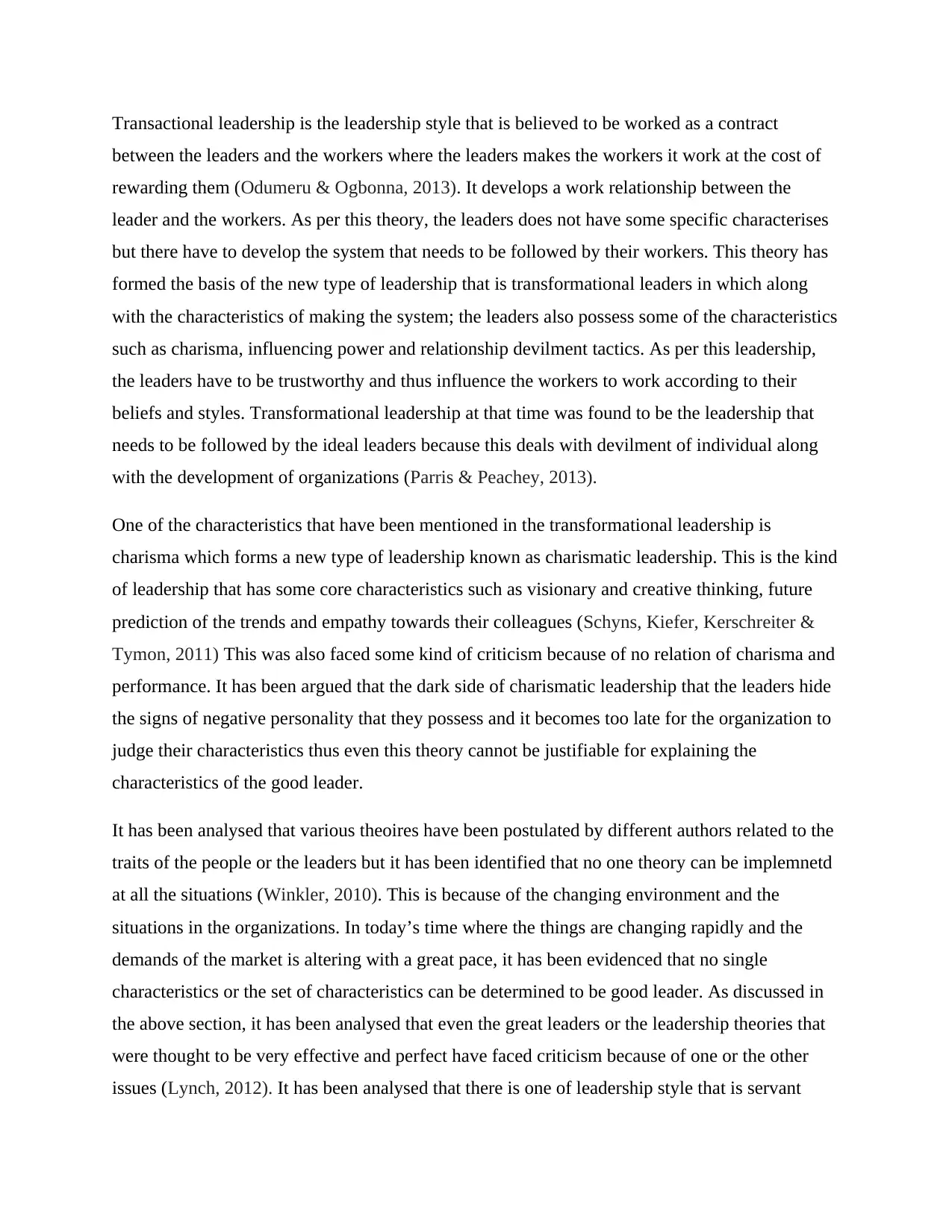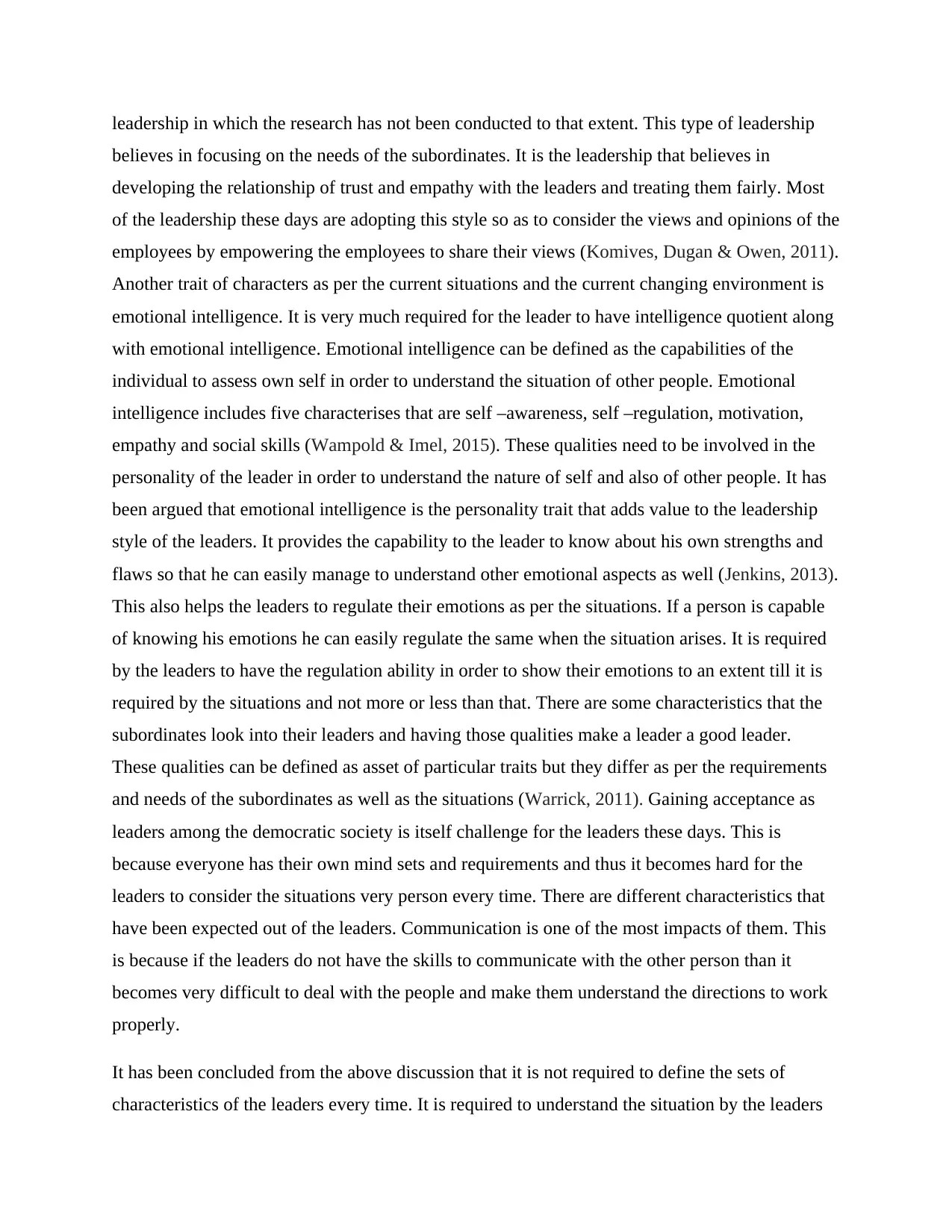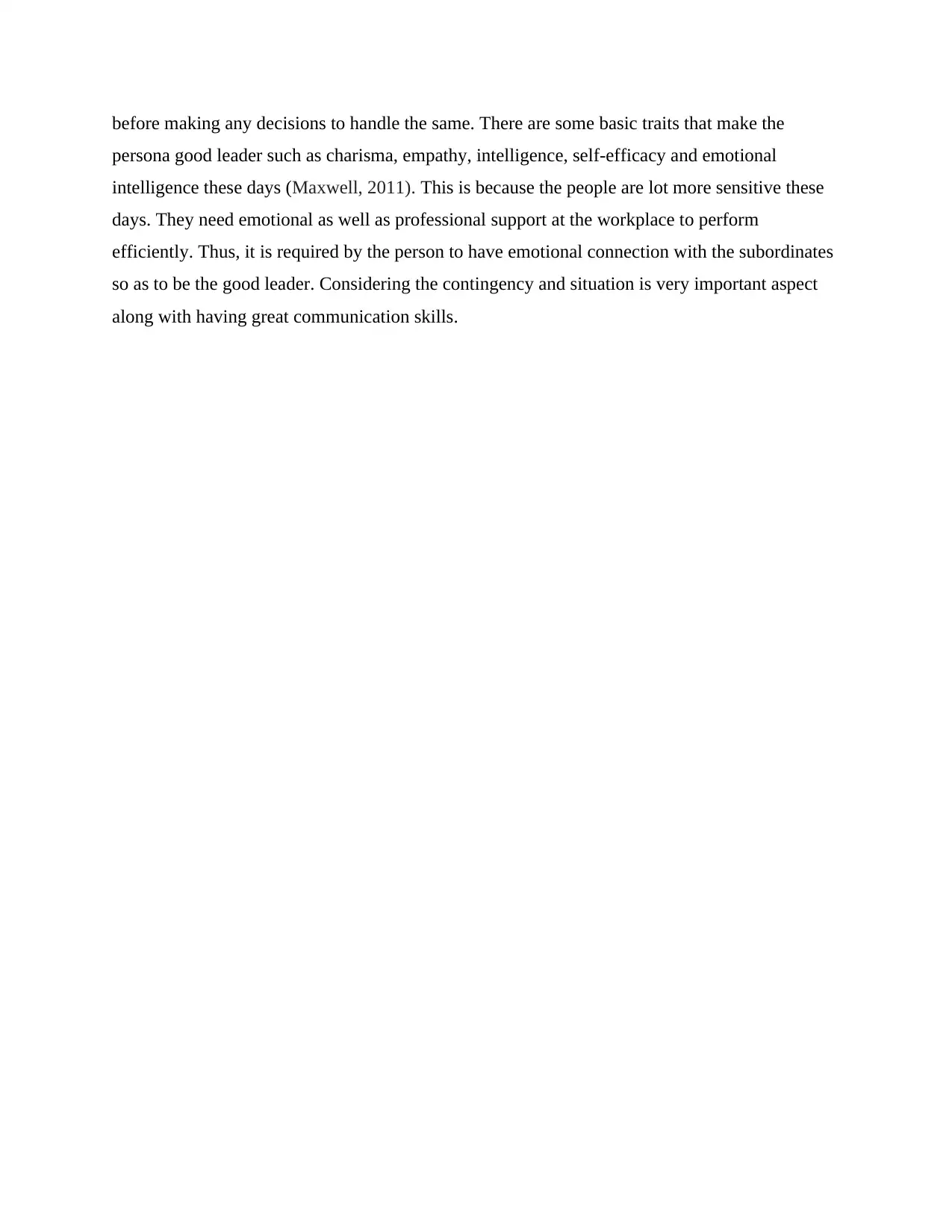Effective Leadership: Traits, Theories, and Contemporary Issues
VerifiedAdded on 2020/03/16
|5
|1971
|61
Essay
AI Summary
This essay delves into the multifaceted concept of leadership, examining various theories and essential characteristics that define a good leader. It begins by highlighting the crucial role leaders play in organizations and society, emphasizing the shift towards democratic workplaces where employee opinions are valued. The essay then explores different leadership theories, starting with the trait theory, which posits that leaders are born with innate qualities. It then transitions to transactional and transformational leadership styles, discussing their evolution and impact. The essay also covers charismatic leadership, its strengths, and weaknesses. Furthermore, it analyzes servant leadership and the importance of emotional intelligence in contemporary leadership. The discussion concludes by emphasizing the need for leaders to adapt to changing environments and possess a combination of traits, including communication skills, charisma, empathy, and emotional intelligence, to effectively guide and motivate their teams. The essay draws on various academic sources to support its arguments.

WHAT MAKES A GOOD LEADER?
Leaders play a very important role in the organization as well as in the whole world. Most of the
countries are democratic in nature and thus they require an effective leader to lead the country.
Even the businesses are experiencing the nature of democracy and the employee opinions are
becoming the important part to be considered. Without a good leaders and an effective
leadership, there is no sense of having a good team. This is because of the team is not directed to
work in a particular path that is correct; the efforts made by them will always waste. There are
many definition that has been given to the concept of leader and leadership, but the crux of all
the definitions suggests that leadership is the ability of the person to lead others and to guide
them in order to show them the path on which they have to go so as to achieve the individual as
well as organizational objectives. It has been analysed that there are many other situational
context that needs to be considered at the time of leadership or leading others. This is because
there are contingencies that affect the decision making process of the leaders at times. This is the
quality of the good leader to handle the situation at its bet. This is because situations are the most
important factors that affect the use of power of the leaders at the great extent.
There are different theories that are kinks with leadership since years. The development of the
businesses and the change in the skills and the demands of the market require different types of
leadership (Avolio & Yammarino, 2013). These are the situations that have evolved the
leadership theories from years. The first theory that has been discussed formally about the
leadership is the trait theory. This theory suggests that leaders are born and cannot be made.
According to this theory, there are some characteristics and habits of good leaders that
differentiate them from the ordinary leaders and these characteristics are believed to be in them
since they were born. The concept of believing that leaders are born and the leadership skills are
innate has dominated the era before Second World War (Sipe & Frick, 2015). There were
different traits that has been identified as the trait for being a good leaders such as self-efficacy,
dominance, intelligence etc. this theory was criticized by some of the theorists and suggests that
there is no concern of situation in their theory. With this, two new theories evolved called as
transformational and transactional leadership.
Leaders play a very important role in the organization as well as in the whole world. Most of the
countries are democratic in nature and thus they require an effective leader to lead the country.
Even the businesses are experiencing the nature of democracy and the employee opinions are
becoming the important part to be considered. Without a good leaders and an effective
leadership, there is no sense of having a good team. This is because of the team is not directed to
work in a particular path that is correct; the efforts made by them will always waste. There are
many definition that has been given to the concept of leader and leadership, but the crux of all
the definitions suggests that leadership is the ability of the person to lead others and to guide
them in order to show them the path on which they have to go so as to achieve the individual as
well as organizational objectives. It has been analysed that there are many other situational
context that needs to be considered at the time of leadership or leading others. This is because
there are contingencies that affect the decision making process of the leaders at times. This is the
quality of the good leader to handle the situation at its bet. This is because situations are the most
important factors that affect the use of power of the leaders at the great extent.
There are different theories that are kinks with leadership since years. The development of the
businesses and the change in the skills and the demands of the market require different types of
leadership (Avolio & Yammarino, 2013). These are the situations that have evolved the
leadership theories from years. The first theory that has been discussed formally about the
leadership is the trait theory. This theory suggests that leaders are born and cannot be made.
According to this theory, there are some characteristics and habits of good leaders that
differentiate them from the ordinary leaders and these characteristics are believed to be in them
since they were born. The concept of believing that leaders are born and the leadership skills are
innate has dominated the era before Second World War (Sipe & Frick, 2015). There were
different traits that has been identified as the trait for being a good leaders such as self-efficacy,
dominance, intelligence etc. this theory was criticized by some of the theorists and suggests that
there is no concern of situation in their theory. With this, two new theories evolved called as
transformational and transactional leadership.
Paraphrase This Document
Need a fresh take? Get an instant paraphrase of this document with our AI Paraphraser

Transactional leadership is the leadership style that is believed to be worked as a contract
between the leaders and the workers where the leaders makes the workers it work at the cost of
rewarding them (Odumeru & Ogbonna, 2013). It develops a work relationship between the
leader and the workers. As per this theory, the leaders does not have some specific characterises
but there have to develop the system that needs to be followed by their workers. This theory has
formed the basis of the new type of leadership that is transformational leaders in which along
with the characteristics of making the system; the leaders also possess some of the characteristics
such as charisma, influencing power and relationship devilment tactics. As per this leadership,
the leaders have to be trustworthy and thus influence the workers to work according to their
beliefs and styles. Transformational leadership at that time was found to be the leadership that
needs to be followed by the ideal leaders because this deals with devilment of individual along
with the development of organizations (Parris & Peachey, 2013).
One of the characteristics that have been mentioned in the transformational leadership is
charisma which forms a new type of leadership known as charismatic leadership. This is the kind
of leadership that has some core characteristics such as visionary and creative thinking, future
prediction of the trends and empathy towards their colleagues (Schyns, Kiefer, Kerschreiter &
Tymon, 2011) This was also faced some kind of criticism because of no relation of charisma and
performance. It has been argued that the dark side of charismatic leadership that the leaders hide
the signs of negative personality that they possess and it becomes too late for the organization to
judge their characteristics thus even this theory cannot be justifiable for explaining the
characteristics of the good leader.
It has been analysed that various theoires have been postulated by different authors related to the
traits of the people or the leaders but it has been identified that no one theory can be implemnetd
at all the situations (Winkler, 2010). This is because of the changing environment and the
situations in the organizations. In today’s time where the things are changing rapidly and the
demands of the market is altering with a great pace, it has been evidenced that no single
characteristics or the set of characteristics can be determined to be good leader. As discussed in
the above section, it has been analysed that even the great leaders or the leadership theories that
were thought to be very effective and perfect have faced criticism because of one or the other
issues (Lynch, 2012). It has been analysed that there is one of leadership style that is servant
between the leaders and the workers where the leaders makes the workers it work at the cost of
rewarding them (Odumeru & Ogbonna, 2013). It develops a work relationship between the
leader and the workers. As per this theory, the leaders does not have some specific characterises
but there have to develop the system that needs to be followed by their workers. This theory has
formed the basis of the new type of leadership that is transformational leaders in which along
with the characteristics of making the system; the leaders also possess some of the characteristics
such as charisma, influencing power and relationship devilment tactics. As per this leadership,
the leaders have to be trustworthy and thus influence the workers to work according to their
beliefs and styles. Transformational leadership at that time was found to be the leadership that
needs to be followed by the ideal leaders because this deals with devilment of individual along
with the development of organizations (Parris & Peachey, 2013).
One of the characteristics that have been mentioned in the transformational leadership is
charisma which forms a new type of leadership known as charismatic leadership. This is the kind
of leadership that has some core characteristics such as visionary and creative thinking, future
prediction of the trends and empathy towards their colleagues (Schyns, Kiefer, Kerschreiter &
Tymon, 2011) This was also faced some kind of criticism because of no relation of charisma and
performance. It has been argued that the dark side of charismatic leadership that the leaders hide
the signs of negative personality that they possess and it becomes too late for the organization to
judge their characteristics thus even this theory cannot be justifiable for explaining the
characteristics of the good leader.
It has been analysed that various theoires have been postulated by different authors related to the
traits of the people or the leaders but it has been identified that no one theory can be implemnetd
at all the situations (Winkler, 2010). This is because of the changing environment and the
situations in the organizations. In today’s time where the things are changing rapidly and the
demands of the market is altering with a great pace, it has been evidenced that no single
characteristics or the set of characteristics can be determined to be good leader. As discussed in
the above section, it has been analysed that even the great leaders or the leadership theories that
were thought to be very effective and perfect have faced criticism because of one or the other
issues (Lynch, 2012). It has been analysed that there is one of leadership style that is servant

leadership in which the research has not been conducted to that extent. This type of leadership
believes in focusing on the needs of the subordinates. It is the leadership that believes in
developing the relationship of trust and empathy with the leaders and treating them fairly. Most
of the leadership these days are adopting this style so as to consider the views and opinions of the
employees by empowering the employees to share their views (Komives, Dugan & Owen, 2011).
Another trait of characters as per the current situations and the current changing environment is
emotional intelligence. It is very much required for the leader to have intelligence quotient along
with emotional intelligence. Emotional intelligence can be defined as the capabilities of the
individual to assess own self in order to understand the situation of other people. Emotional
intelligence includes five characterises that are self –awareness, self –regulation, motivation,
empathy and social skills (Wampold & Imel, 2015). These qualities need to be involved in the
personality of the leader in order to understand the nature of self and also of other people. It has
been argued that emotional intelligence is the personality trait that adds value to the leadership
style of the leaders. It provides the capability to the leader to know about his own strengths and
flaws so that he can easily manage to understand other emotional aspects as well (Jenkins, 2013).
This also helps the leaders to regulate their emotions as per the situations. If a person is capable
of knowing his emotions he can easily regulate the same when the situation arises. It is required
by the leaders to have the regulation ability in order to show their emotions to an extent till it is
required by the situations and not more or less than that. There are some characteristics that the
subordinates look into their leaders and having those qualities make a leader a good leader.
These qualities can be defined as asset of particular traits but they differ as per the requirements
and needs of the subordinates as well as the situations (Warrick, 2011). Gaining acceptance as
leaders among the democratic society is itself challenge for the leaders these days. This is
because everyone has their own mind sets and requirements and thus it becomes hard for the
leaders to consider the situations very person every time. There are different characteristics that
have been expected out of the leaders. Communication is one of the most impacts of them. This
is because if the leaders do not have the skills to communicate with the other person than it
becomes very difficult to deal with the people and make them understand the directions to work
properly.
It has been concluded from the above discussion that it is not required to define the sets of
characteristics of the leaders every time. It is required to understand the situation by the leaders
believes in focusing on the needs of the subordinates. It is the leadership that believes in
developing the relationship of trust and empathy with the leaders and treating them fairly. Most
of the leadership these days are adopting this style so as to consider the views and opinions of the
employees by empowering the employees to share their views (Komives, Dugan & Owen, 2011).
Another trait of characters as per the current situations and the current changing environment is
emotional intelligence. It is very much required for the leader to have intelligence quotient along
with emotional intelligence. Emotional intelligence can be defined as the capabilities of the
individual to assess own self in order to understand the situation of other people. Emotional
intelligence includes five characterises that are self –awareness, self –regulation, motivation,
empathy and social skills (Wampold & Imel, 2015). These qualities need to be involved in the
personality of the leader in order to understand the nature of self and also of other people. It has
been argued that emotional intelligence is the personality trait that adds value to the leadership
style of the leaders. It provides the capability to the leader to know about his own strengths and
flaws so that he can easily manage to understand other emotional aspects as well (Jenkins, 2013).
This also helps the leaders to regulate their emotions as per the situations. If a person is capable
of knowing his emotions he can easily regulate the same when the situation arises. It is required
by the leaders to have the regulation ability in order to show their emotions to an extent till it is
required by the situations and not more or less than that. There are some characteristics that the
subordinates look into their leaders and having those qualities make a leader a good leader.
These qualities can be defined as asset of particular traits but they differ as per the requirements
and needs of the subordinates as well as the situations (Warrick, 2011). Gaining acceptance as
leaders among the democratic society is itself challenge for the leaders these days. This is
because everyone has their own mind sets and requirements and thus it becomes hard for the
leaders to consider the situations very person every time. There are different characteristics that
have been expected out of the leaders. Communication is one of the most impacts of them. This
is because if the leaders do not have the skills to communicate with the other person than it
becomes very difficult to deal with the people and make them understand the directions to work
properly.
It has been concluded from the above discussion that it is not required to define the sets of
characteristics of the leaders every time. It is required to understand the situation by the leaders
⊘ This is a preview!⊘
Do you want full access?
Subscribe today to unlock all pages.

Trusted by 1+ million students worldwide

before making any decisions to handle the same. There are some basic traits that make the
persona good leader such as charisma, empathy, intelligence, self-efficacy and emotional
intelligence these days (Maxwell, 2011). This is because the people are lot more sensitive these
days. They need emotional as well as professional support at the workplace to perform
efficiently. Thus, it is required by the person to have emotional connection with the subordinates
so as to be the good leader. Considering the contingency and situation is very important aspect
along with having great communication skills.
persona good leader such as charisma, empathy, intelligence, self-efficacy and emotional
intelligence these days (Maxwell, 2011). This is because the people are lot more sensitive these
days. They need emotional as well as professional support at the workplace to perform
efficiently. Thus, it is required by the person to have emotional connection with the subordinates
so as to be the good leader. Considering the contingency and situation is very important aspect
along with having great communication skills.
Paraphrase This Document
Need a fresh take? Get an instant paraphrase of this document with our AI Paraphraser

References:
Avolio, B. J., & Yammarino, F. J. (Eds.). (2013). Introduction to, and overview of,
transformational and charismatic leadership. In Transformational and Charismatic
Leadership: The Road Ahead 10th Anniversary Edition (pp. xxvii-xxxiii). Emerald Group
Publishing Limited.
Jenkins, R. (2013). What makes a good leader. The Chronicle of Higher Education.
Komives, S. R., Dugan, J. P., & Owen, J. E. (2011). The handbook for student leadership
development. John Wiley & Sons.
Lynch, M. (2012). A guide to effective school leadership theories. Routledge.
Maxwell, J. C. (2011). The 360 Degree Leader with Workbook: Developing Your Influence from
Anywhere in the Organization. Thomas Nelson Inc.
Odumeru, J. A., & Ogbonna, I. G. (2013). Transformational vs. transactional leadership theories:
Evidence in literature. International Review of Management and Business Research, 2(2),
355.
Schyns, B., Kiefer, T., Kerschreiter, R., & Tymon, A. (2011). Teaching implicit leadership
theories to develop leaders and leadership: How and why it can make a
difference. Academy of Management Learning & Education, 10(3), 397-408.
Warrick, D. D. (2011). The urgent need for skilled transformational leaders: Integrating
transformational leadership and organization development. Journal of leadership,
Accountability, and Ethics, 8(5), 11-26.
Winkler, I. (2010). Contemporary leadership theories: Enhancing the understanding of the
complexity, subjectivity and dynamic of leadership. Springer Science & Business Media.
Parris, D. L., & Peachey, J. W. (2013). A systematic literature review of servant leadership
theory in organizational contexts. Journal of business ethics, 113(3), 377-393.
Sipe, J. W., & Frick, D. M. (2015). Seven pillars of servant leadership: Practicing the wisdom of
leading by serving. Paulist Press.
Avolio, B. J., & Yammarino, F. J. (Eds.). (2013). Introduction to, and overview of,
transformational and charismatic leadership. In Transformational and Charismatic
Leadership: The Road Ahead 10th Anniversary Edition (pp. xxvii-xxxiii). Emerald Group
Publishing Limited.
Jenkins, R. (2013). What makes a good leader. The Chronicle of Higher Education.
Komives, S. R., Dugan, J. P., & Owen, J. E. (2011). The handbook for student leadership
development. John Wiley & Sons.
Lynch, M. (2012). A guide to effective school leadership theories. Routledge.
Maxwell, J. C. (2011). The 360 Degree Leader with Workbook: Developing Your Influence from
Anywhere in the Organization. Thomas Nelson Inc.
Odumeru, J. A., & Ogbonna, I. G. (2013). Transformational vs. transactional leadership theories:
Evidence in literature. International Review of Management and Business Research, 2(2),
355.
Schyns, B., Kiefer, T., Kerschreiter, R., & Tymon, A. (2011). Teaching implicit leadership
theories to develop leaders and leadership: How and why it can make a
difference. Academy of Management Learning & Education, 10(3), 397-408.
Warrick, D. D. (2011). The urgent need for skilled transformational leaders: Integrating
transformational leadership and organization development. Journal of leadership,
Accountability, and Ethics, 8(5), 11-26.
Winkler, I. (2010). Contemporary leadership theories: Enhancing the understanding of the
complexity, subjectivity and dynamic of leadership. Springer Science & Business Media.
Parris, D. L., & Peachey, J. W. (2013). A systematic literature review of servant leadership
theory in organizational contexts. Journal of business ethics, 113(3), 377-393.
Sipe, J. W., & Frick, D. M. (2015). Seven pillars of servant leadership: Practicing the wisdom of
leading by serving. Paulist Press.
1 out of 5
Related Documents
Your All-in-One AI-Powered Toolkit for Academic Success.
+13062052269
info@desklib.com
Available 24*7 on WhatsApp / Email
![[object Object]](/_next/static/media/star-bottom.7253800d.svg)
Unlock your academic potential
Copyright © 2020–2025 A2Z Services. All Rights Reserved. Developed and managed by ZUCOL.




